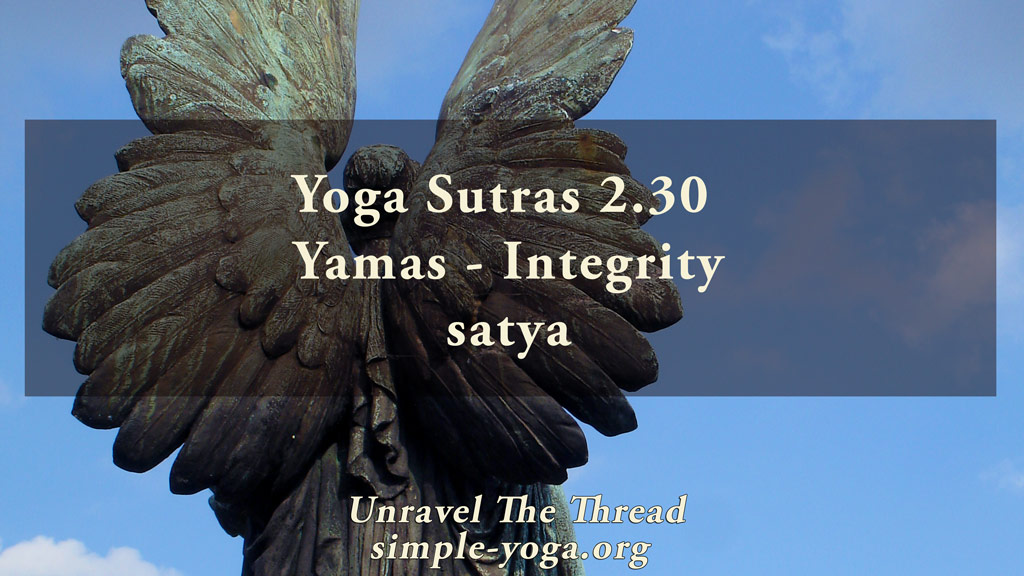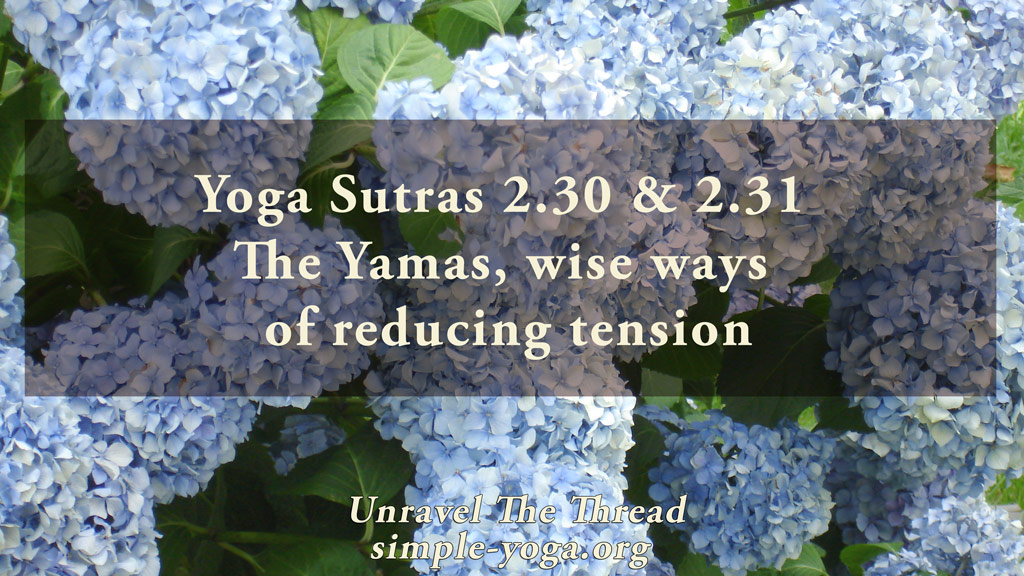
2.29 The eight limbs of yoga
September 11, 2020
2.30 Yamas – Integrity (Satya)
September 21, 2020
2.29 The eight limbs of yoga
September 11, 2020
2.30 Yamas – Integrity (Satya)
September 21, 20202.30 & 2.31 The Yamas, wise ways for removing strain

2.30 & 2.31 The yamas, wise ways for removing strain
2.30 The yamas, wise ways for removing strain, are: Love (ahimsa), Integrity (satya), Fairness and Generosity (asteya), Curiosity and Reverence for Life (brahmacharya) and Abundance and Simplicity (aparigraha).
2.31 The yamas are a great universal vow to appreciate and honor the interdependent nature of life in all forms and manifestations.
The yamas are guidelines suggesting ways to establish intelligent relationships with yourself and with the world around you. In Sanskrit, yama means self-control. Like any other set of guidelines, the yamas can be formulated in either a positive or negative way, as Dos and Don’ts. However, choosing to focus on what not to do can lead some people to become rigid and dogmatic. Moreover, focusing on the Don’ts aspect, does not offer constructive ways to apply these guidelines into actions. Alternatively, you may see the yamas as logical suggestions for opening your mind, by removing strain. The yamas also plant seeds of wisdom that you can live by. The yamas are wisdom, understood as pure common sense. Therefore, they apply at all times, in all places, and to every person. As in all aspects of yoga, it is up to each practitioner to discover the most suitable ways of exploring these guidelines. When you are trying to apply the yamas, be aware of internal arguments you may have with yourself. These arguments indicate that you might be trying to find ways to not apply the yama fully. Please remember that the practice is to apply the yamas to the extent that is possible for you at the present time, without generating more reasons to judge yourself. Keep in mind that the practice of the yamas is a process. It develops gradually, according to the commitment and earnestness of each person. Yet, every tiny step towards applying the yamas, creates the opportunity to see yourself and the world around you in a new light and through a different lens.
In this episode we will explore the first yama, ahimsa, and in the following episodes we will inquire into each of the other yamas individually.
LOVE – AHIMSA
Ahimsa is the Sanskrit word resulting of combining himsa with the prefix “a,” which negates himsa. Himsa means slaying, killing, hurt, harmful act, violence, injuring. Ahimsa is the opposite of himsa. The first yama, ahimsa, can be understood as looking at yourself and the world around you through the eyes of love and compassion. What do you see when you choose to be loving and kind? What happens inside and outside of you? This is an idea worth exploring in your everyday actions and interactions. It is quite likely that when you try to apply this view of love and kindness in your own life, you will start to see more clearly some of your deeply entrenched assumptions. For instance, do you see the world as a hostile and dangerous place or as a friendly place? Do you prefer stories of competition or cooperation? Other times, you may find obstacles in erroneous beliefs, such as thinking that you are incomplete or not worthy of love. Contemplate the simple question: Are you worthy of unconditional love? As you ponder these questions, some of your beliefs will become more apparent. You may also see how you create stories to justify some of your beliefs. With all this experiential information available to you, you can decide if these beliefs are helpful, or unhelpful, by noticing if they contribute to enhance the quality of your experience as well as the quality of your participation in every moment of your life.
Another path for exploring ahimsa is to take time to recall an inspiring event, memory or idea. Explore how this idea influences the sensations in your body, your breathing patterns, your ways of thinking, your decisions and your mindset. Then, bring into your inner space a memory of something that creates some discomfort for you, such as the memory of a challenging, difficult or embarrassing moment. Then, feel the effects in your body, mind, breathing, movement, and attitude. What is the resulting quality on your presence and overall experience? Which of these two options informs your general attitude and mindset more often? Is it possible for you to choose one or the other consciously? What happens when you choose your attitude more consciously? How does this affect your relationship with yourself, with others and with the world around you? One more way of cultivating ahimsa is by using a mantra such as I AM LOVE, or I LOVE UNCONDITIONALLY.
As usual, one more way of exploring the meaning of this sutra is by chanting it.
You can choose to chant it in its traditional form with some of the words coming together:
For sutra 2.30
2.30 ahiṃsāsatyāsteya brahmacaryāparigrahāḥ yamāḥ
अहिंसासत्यास्तेय ब्रह्मचर्यापरिग्रहाः यमाः ॥३०॥
Another option is to chant each word in the sutra individually:
- ahiṃsā
- satya
- asteya
- brahmacarya
- aparigrahāḥ
- yamāḥ
For sutra 2.31, chanting all the words together:
2.31 jātideśakālasamayānavacchinnāḥ sārvabhaumāmahāvratam
जातिदेशकालसमयानवच्छिन्नाः सार्वभौमामहाव्रतम् ॥३१॥
And chanting each word individually,
- jāti
- deśa
- kāla
- samaya
- anavacchinnāḥ
- sārvabhaumāḥ
- mahāvratam
If you prefer, you may listen to the podcast:
Unravel the thread is now available as a book!
If you find Simple-Yoga.org and Unravel the thread useful, consider supporting my labor with a donation, you may also donate using PayPal or Venmo. Thank you!
